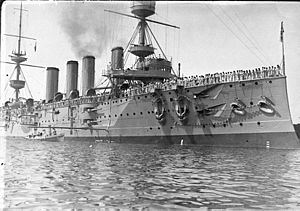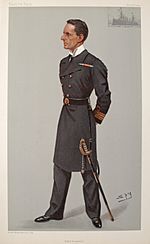HMS Powerful (1895) facts for kids

Sailors line the deck of Powerful in Sydney Harbour, Australia (1905–1912)
|
|
Quick facts for kids History |
|
|---|---|
| Name | Powerful |
| Builder | Vickers Limited, Barrow-in-Furness |
| Laid down | 10 March 1894 |
| Launched | 24 July 1895 |
| Commissioned | 8 June 1897 |
| Renamed | Impregnable, November 1919 |
| Reclassified | Training ship, August 1912 |
| Stricken | 27 March 1929 |
| Fate | Sold for scrap, August 1929 |
| General characteristics (as built) | |
| Class and type | Powerful-class protected cruiser |
| Displacement | 14,200 long tons (14,400 t) (normal) |
| Length | 538 ft (164.0 m) (o/a) |
| Beam | 71 ft (21.6 m) |
| Draught | 27 ft (8.2 m) |
| Installed power |
|
| Propulsion |
|
| Speed | 22 knots (41 km/h; 25 mph) |
| Range | 7,000 nmi (13,000 km; 8,100 mi) at 14 knots (26 km/h; 16 mph) |
| Complement | 894 (designed); 799 (1916) |
| Armament |
|
| Armour |
|
HMS Powerful was a large warship built for the Royal Navy (RN) in the 1890s. She was the first ship of her kind, known as a protected cruiser, and was designed to be fast and powerful. Powerful served in different parts of the world, including the China Station (a naval base in China).
One of her most famous moments was helping out during the Second Boer War in South Africa. After a major repair, she became the main ship (flagship) for the Australia Station. Later, she became a training ship to teach young sailors. Powerful served until 1929 when she was sold for scrap metal.
Contents
Building a Powerful Warship
The Powerful-class cruisers were built to compete with a large Russian warship called Rurik. That Russian ship was designed to attack merchant ships over long distances. So, the British needed their own ships to be very fast and able to travel far to catch it.
Ship Size and Speed
Powerful was a big ship, weighing about 14,200 tons. She was about 164 meters (538 feet) long, 21.6 meters (71 feet) wide, and sat 8.2 meters (27 feet) deep in the water. To make her move, she had two powerful steam engines and 48 boilers. These engines could produce 25,000 horsepower, allowing her to reach a top speed of 22 knots (about 41 kilometers per hour). She could travel about 7,000 nautical miles (13,000 kilometers) at a slower speed of 14 knots. When fully staffed, she had a crew of 894 officers and sailors.
Ship's Weapons and Protection
Powerful carried a lot of firepower. Her main weapons were two large 9.2-inch guns, placed in turrets at the front and back of the ship. She also had twelve 6-inch guns located in special armored rooms called casemates along her sides. These were some of the first casemates to have guns on two different levels.
For defense against smaller, faster ships like torpedo boats, she had sixteen 12-pounder guns and twelve 3-pounder guns. She also had four underwater torpedo tubes, which could fire torpedoes from either side of the ship. To protect the ship and its crew, Powerful had strong armor made of a material called Harvey armor. This armor was thickest around the command center (conning tower) and the gun turrets.
Service and Adventures
Powerful was built by Vickers Limited in Barrow-in-Furness, England. She was started on 10 March 1894 and launched into the water on 24 July 1895. The ship officially joined the Royal Navy on 8 June 1897, with Captain Hedworth Lambton in charge.
Early Days and the China Station
Her first job was to serve on the China Station, a British naval base in China. Before heading there, she took part in a special fleet review to celebrate Queen Victoria's Diamond Jubilee in June 1897. While sailing between China and Japan in 1898, some of her stokers (the crew who managed the ship's engines) caused trouble, but it was resolved.
Heroic Actions in the Boer War
In 1899, Powerful was ordered to return home. However, tensions were rising in South Africa between the British and the Boers. So, instead of taking the shorter route through the Suez Canal, she sailed around the southern tip of Africa. Captain Lambton even picked up some soldiers from the island of Mauritius on his way.
When Powerful arrived in South Africa, the Second Boer War had just begun. Her sister ship, Terrible, had already arrived. Captain Percy Scott from Terrible quickly created special wheeled platforms for some of their ship's guns. This allowed the heavy naval guns to be moved and used on land.
The Siege of Ladysmith
The British forces at Ladysmith were under attack and needed more long-range guns. Powerful quickly took four of these guns to Durban. Captain Lambton then got two more 12-pounder guns and led a group of sailors, known as a naval brigade, to Ladysmith. They arrived just before the town was completely surrounded.
After the town was rescued in February 1900, the naval brigade left Ladysmith. Powerful then sailed back to England, arriving in Portsmouth on 11 April.
A Hero's Welcome
The people in Britain were incredibly excited about the "heroes of Ladysmith." Captain Lambton became very famous. Queen Victoria herself sent a message thanking the Naval Brigade for their valuable service. There was a big celebration and a parade through London, which was even filmed!
A newspaper described Powerful's return:
As the great vessel steamed into Portsmouth Harbour at four o'clock this afternoon, she was greeted with thunders of applause .... vessels lying off here were dressed with flags, and their crews, swarming along the yards, swelled the roar of welcome......By three o'clock the jetty was thronged with men, women and children. ... A more eager, joyous gathering I never saw.....We cheered, we waved hats and handkerchiefs and we were half wild with delight.
The naval brigade even paraded for Queen Victoria at Windsor Castle. Today, the Royal Navy's field gun competition still remembers the brave actions of Terrible and Powerful at Ladysmith. A school in Ladysmith was even named after Lieutenant Frederick Greville Egerton, an officer from Powerful who died there.
Later Career and Training Role
After her heroic return, Powerful was taken out of active service for a while. She then underwent a long repair and upgrade between 1902 and 1903. During this time, four more 6-inch guns were added to her.
In 1905, Captain Lionel Halsey took command of Powerful. She became the main ship for the Australia Station, which meant she was the most important ship for the Royal Navy in Australian waters. Halsey stayed in this role until 1908.
Adventures in Australia
In December 1905, Powerful was in Fremantle, Australia. In 1907, she received a new crew in Colombo, Ceylon (now Sri Lanka). On 3 February 1908, Powerful helped make history by being part of the first radio transmission across the Tasman Sea (between Australia and New Zealand).
A journalist named Charles Bean joined the ship in August 1908 to report on the visit of sixteen American warships, known as the Great White Fleet. Bean later wrote a book about his experiences called With the Flagship in the South. In 1911, Powerful visited Auckland, New Zealand, to check on naval facilities there.
Becoming a Training Ship
In January 1912, Powerful was ordered back to England. On her way, she carried the body of Alexander Duff, 1st Duke of Fife from Port Said, Egypt. Once back home, she was briefly part of a reserve fleet.
In August 1912, Powerful was given a new job: she became a Boys Training Ship at Devonport. This meant she would be used to train young sailors for the Royal Navy. In 1913, she became a support ship for HMS Impregnable, another training establishment.
In November 1919, Powerful was renamed Impregnable I to reflect her new role. She continued as a training ship until 27 March 1929, when she was finally taken out of service. In August 1929, she was sold to be broken up for scrap metal, ending her long and interesting career.


